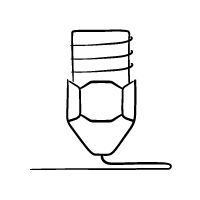PLA
PLA Filament, or Polylactic Acid, is a popular and user-friendly material for 3D printing. It provides accurate dimensions, is cost-effective and is also relatively easy to use. Its environmentally friendly properties come from renewable sources such as corn and sugar cane.
Ease of use
Strength







Extruder
190-210 °C
Does not require any special Hotend


Pray
45-70 °C
Does not require any enclosure


Cooling
100%
For the best bearing bond
When is PLA used?
Polyactic Acid (PLA) is a biodegradable thermoplastic that has become popular in 3D printing. Made from renewable sources such as corn starch or sugar cane, PLA offers an environmentally friendly and sustainable solution with advantages such as easy processing, low shrinkage and minimal emissions of harmful substances. Its biodegradability makes it an attractive choice for environmentally conscious users who want to reduce their impact on the planet.
PLA is valuable in the 3D printing community for prototyping, hobby writing, and education. Its field of use spans various industries such as product development, architecture and medical research. PLA's ease of use and biodegradability drive innovation and promote a more sustainable future for the manufacturing industry.
Advantages
- Cheap
- Environmentally friendly
- Wide color spectrum
Disadvantages
- Skirt
- Low melting point
- Absorbs water
Tip
Prototypes: Create fast and precise prototypes across different industries. PLA provides detailed and accurate results that help you visualize your ideas in a cost-effective way.
Hobby writing and Education: Whether you are a beginner or experienced, PLA is the perfect material for 3D printing. Its user-friendly nature makes it an ideal resource for learning and exploring the technology.
Environmentally Friendly Alternative: By using PLA, you contribute to a more sustainable future. Made from renewable sources such as corn and sugarcane, PLA offers biodegradable options for products and packaging, while delivering high-quality results.
Print speed: Use a medium print speed to maintain accuracy and detail.
Layer Height: Choose an appropriate layer height depending on your project – thinner layers give more detailed results.
Retraction: Adjust the retraction settings to minimize wire strands and impurities in the print.
Bed Adhesion (Adhesion to the Building Plate): Use kapton tape, glass or special printing surface materials to improve adhesion and reduce the risk of shearing.
Check Humidity: Store the PLA material in a dry and sealed container to prevent moisture absorption and quality degradation.
PLA vs PLA+ vs PLA PRO
| Feature | PLA | PLA+ | PLA PRO |
|---|---|---|---|
| Material composition | Polylactic Acid | Modified Polylactic Acid | Enhanced Polylactic Acid |
| Strength | ● ○ ○ | ● ● ○ | ● ● ● |
| Flexibility | Brittle | Slightly Flexible | Rigid |
| Printability | ● ● ● | ● ● ● | ● ● ○ |
| Surface Finish | Standard | Improved | Smooth |
| Layer Adhesion | ● ○ ○ | ● ● ○ | ● ● ● |
| Temperature Resistance | ● ○ ○ | ● ● ○ | ● ● ● |
| Applications | Basic Prototypes, Low-Stress Models | Prototypes, Functional Parts | Prototypes, Functional Parts, Mechanical Components |
*In relation to each other
ABS





PETG





Miscellaneous




